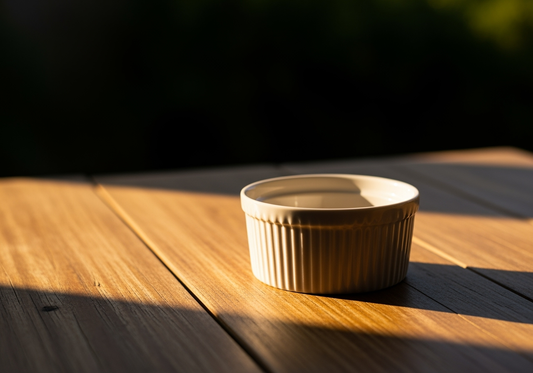Small but mighty, ramekins are one of the most versatile tools in any kitchen. From baking decadent soufflés to serving sauces and snacks, these little bowls do it all. But many home cooks wonder—can they go in the oven, microwave, freezer, or even an air fryer?
In this guide, we’ll answer the most common questions about ramekins, share practical tips, and explore alternatives if you don’t have one handy.
Can ramekins go in the microwave?
Yes, most ramekins are microwave safe—as long as they are made from ceramic, porcelain, or glass that’s specifically marked microwave safe. Like these we have from Kayali are microwave safe.
These materials can handle quick heating without cracking. However, there are a few things to keep in mind:
· Avoid sudden temperature changes. For example, don’t take a ramekin straight from the freezer and put it in the microwave.
· Check for metallic rims or decorations. If your ramekin has gold or silver trim, it should not go in the microwave.
· Use caution with glass ramekins. Some types of glass can shatter if exposed to rapid temperature changes.
When reheating leftovers or melting butter in a ramekin, always use a lower power setting and short intervals to avoid overheating.
How do I know if my ramekin is oven safe?
The simplest way is to look at the bottom of the ramekin or the product packaging. Most reputable brands stamp their ramekins with “oven safe,” “microwave safe,” or similar markings like this one that we have does.
If you’re unsure:
1. Check the material. Ceramic, porcelain, and tempered glass are usually safe. Plastic ramekins are not.
2. Do a quick test. Place the empty ramekin in a cold oven, then slowly heat it up to 350°F (175°C). If it comes out intact, it’s oven safe.
3. Avoid thin or decorative pieces. They might be better suited for serving rather than baking.
Can I put a ramekin in the oven?
Absolutely! Ramekins are designed for the oven and are commonly used for baked dishes like soufflés, custards, and mini casseroles. Most ceramic or porcelain ramekins are oven safe up to 450–500°F (230–260°C), but it’s always best to check the packaging or manufacturer’s instructions.
Tips for oven use:
· Place ramekins on a baking sheet for stability and easy transfer.
· Avoid exposing cold ramekins directly to a hot oven—let them come to room temperature first to prevent thermal shock.
· Use oven mitts or tongs when handling hot ramekins since they retain heat well.
Do you have to grease ramekins?
It depends on what you’re cooking.
· Yes, grease them if you’re making sticky desserts like soufflés, lava cakes, or custards. A light coat of butter, oil, or cooking spray prevents sticking and helps the dish release smoothly.
· No, you don’t need to grease ramekins if you’re serving cold items like dips, nuts, or condiments.
For baking soufflés, a classic trick is to grease with butter and dust with sugar or flour, which gives the mixture something to cling to as it rises.
Can ramekins go in an air fryer?
Yes, ramekins can go in the air fryer, making them perfect for single-serve desserts, baked eggs, or molten chocolate cakes. Just make sure:
· They are oven safe (since air fryers use high heat similar to ovens).
· They fit comfortably in the basket without touching the heating element.
· You adjust cooking times, as air fryers cook faster than ovens.
Ceramic, porcelain, and glass ramekins work well, but always check your specific model’s safety guidelines.
Can ramekins go in the freezer?
Yes, ramekins can go in the freezer—especially useful for preparing make-ahead desserts or freezing small portions of soup or sauces. However, be mindful of:
· Thermal shock. Don’t move ramekins directly from freezer to oven or microwave. Let them warm up gradually.
· Material strength. Thick ceramic or glass ramekins are better for freezer use than thin or delicate ones.
You can even use freezer-safe ramekins for portioning ice cream or prepping meals in advance.
Can ramekins be glass?
Yes, ramekins can be made of glass, and they’re often a stylish and practical choice. Borosilicate glass ramekins (like Pyrex) handle both hot and cold temperatures well. They’re also see-through, making them great for layered desserts.
However, not all glass ramekins are created equal. Regular glass may crack under high heat or rapid temperature shifts, so check for markings like “oven safe” or “tempered.”
How do you clean a ramekin bowl?
Cleaning ramekins is simple, but baked-on food can sometimes be stubborn. Here are the best methods:
· Soak in warm, soapy water. Let it sit for 15–30 minutes to loosen residue.
· Use a non-abrasive sponge. Avoid steel wool, which can scratch ceramic or glass.
· For tough stains, sprinkle baking soda, add hot water, and let it fizz before scrubbing.
· Dishwasher safe? Many ramekins are, but always double-check the manufacturer’s instructions.
With proper care, ramekins will last for years without losing their shine.
What can I use instead of a ramekin?
Don’t have ramekins? No problem—there are plenty of alternatives depending on what you’re making:
· Muffin tins (great for baking small desserts or individual portions).
· Small oven-safe bowls made from ceramic, glass, or stainless steel.
· Custard cups or Pyrex dessert bowls.
· Teacups (as long as they are oven safe).
The key is to use something with similar heat resistance and size.
Can I use a muffin tin instead of ramekins?
Yes! Muffin tins are a great substitute when you need multiple small servings. They work especially well for:
· Mini soufflés
· Individual cheesecakes
· Lava cakes
· Savoury egg bakes
Pro tip: Grease the muffin tin well or use parchment liners to prevent sticking, since tins don’t have the same non-stick quality as a greased ramekin.


